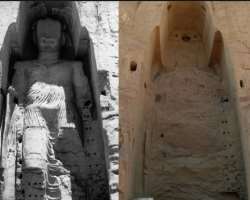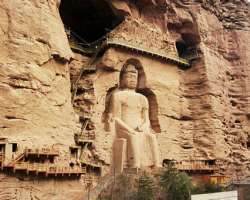Cultural Landscape and Archaeological Remains of the Bamiyan Valley History, Travel Information, Facts And More
Cultural Landscape and Archaeological Remains of the Bamiyan Valley
Rate Cultural Landscape and Archaeological Remains of the Bamiyan Valley as World Heritage Site here
PERSONAL INFORMATION
NAME
Cultural Landscape and Archaeological Remains of the Bamiyan Valley
COUNTRY
Afghanistan
ADDRESS
Bamyan, Afghanistan
CULTURAL LANDSCAPE AND ARCHAEOLOGICAL REMAINS OF THE BAMIYAN VALLEY PICTURE
More Information
About Cultural Landscape and Archaeological Remains of the Bamiyan Valley
The Bamiyan Balley is located in central Afghanistan at an elevation of 2500 meters. It is about 130 kilometers away from the capital city Kabul. The valley had two monumental statues of lord Buddha which belong to the 6th and early 7th centuries. The valley is spread in an area of 105 hectares. It was included in the list of World Heritage Site in Danger in 2003 There is a threat of destroying the ruins of the valley from the Taliban side as the statues were declared idols by the government.
FOLLOW US ON SOCIALS
Some Lesser Known Facts About Cultural Landscape and Archaeological Remains of the Bamiyan Valley
- The two statues were destroyed and blown up on the order of Mullah Mohammed Omar in March 2001 following a declaration of the government that they were idols. Before that, there were two statues, the Eastern Buddha which was 38 meters tall, and Western Buddha which was 55 meters large made in around 570 AD and 618 AD respectively.

- It was a religious site of Buddhists from the second century AD to 770 AD during the Islamic invasion. It lies on the Silk Road (which was the route to China) through the Hindu Kush mountain region. At the time, there were several Buddhist monasteries. The famous Chinese pilgrim Xuanzang visited the place on April 30, 630. It is also said that both the figures were decorated with gold and fine jewels at the time. There is also related statue like those of Bamiyan presented in the Bingling Temple caves in China.

- Though Afghanistan is a Muslim country now, the destruction of the statue is a violation of the freedom of religious expression and was not appreciated by the many of the locals.
- The attack of 2001 was not the first attack on the statues. The statues are suffering since 1221 with the advent of Genghis Khan. Babur ordered to destroy the statues in September 1528, also Mughal emperor Aurangzeb who is known for destroying many temples in India used heavy artillery to destroy the statues. He was successful in breaking the legs of the statues at the time. Also in 18th-century Persian king, Nader Afshar ordered a cannon fire at them.
- Another statue which is 300-meter long of the reclining Buddha was discovered from the site in 2008 with a post of Buddha's Parinirvana. Also, the site is surrounded by a number of caves and surfaces decorated with the paintings from 6th to 8th century which needs protection.
USER RATING FOR CULTURAL LANDSCAPE AND ARCHAEOLOGICAL REMAINS OF THE BAMIYAN VALLEY